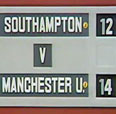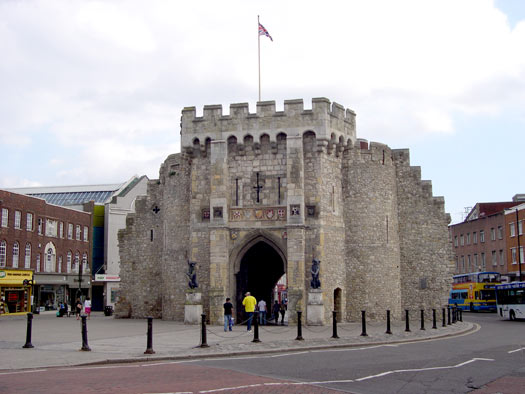|
|
|
It's
A Cup Final Knockout 1976
British Domestic Series
Presenters:
Stuart Hall
Eddie Waring Referee:
Arthur Ellis
Scoregirls:
Hazel Lyons
Dinah May
Leena Skoog
Marie Worth
Production Credits:
Production Team:
Alan Walsh,
Alan Wright; Senior Stage Manager:
Bryan Chapman;
Engineering Manager:
Geoff Lomas;
Sound:
John Drake;
Designers and Games Devisers:
Paul Montague, Paul Trerise; Producer:
Cecil Korer;
Director:
Geoff Wilson
A BBC Manchester Production
|
Key:
Domestic Special
● =
Winner of Special
▲ = Promoted to Position / ▼ =
Demoted to Position |
|
|
GB |
It's
A Cup Final Knockout 1976 |
FA
Cup Final Special |
|
Event Staged: Sunday 25th April 1976
Venue:
Outdoor Sports Centre, Bassett, Southampton, Hampshire, England
Transmission:
BBC1 (GB): Saturday 1st May 1976, 12.20-1.05pm (as part of Cup Final Grandstand)
Celebrity Supporters (non-participating):
Manchester United F.C.- Noel Cantwell and Nobby Stiles (former
Manchester United players), Peter Purves (actor and Blue Peter
presenter)
and Dave Lee Travis
(BBC Radio 1 DJ);
Southampton F.C. - Paul Bennett,
Pat Earle and Hugh Fisher (Southampton players),
Lesley Judd (dancer and Blue Peter presenter), Marilyn Ward (Miss
United Kingdom 1971 and former It's A Knockout scoregirl)
and Tony Blackburn
(BBC Radio 1 DJ).
Weather Conditions: Sunny and Warm |
|
Teams:
Manchester United F.C. v. Southampton
F.C. |
|
Team Members
included:
Manchester United F.C. - Anne Smith (Team Captain), Paul Boston, Dave Bradbury, Phil Burslem, Cliff
Butler, Trevor Butler, Yvonne Butler, Claire George, Joyce Goldstone, Paul
Harvey, Gordon Hill, Paul Wilcox, Jane Williams, Terry Williams;
Southampton F.C. - Roger Butcher, Anne Butt, Lyn Davidge,
Carolyn Jeffrey, Kevin Hart, Peter Harvey, Trevor Hebbard, Gill Long, Sue
Lopes, Britt Newman, Ken Pound, Lyn Savage, Tony Seely. |
|
Games:
The Water Carriers, Throwing Back to Back, Balls Across the Dirigible, Throw
the Drunken Sailor, On Yer Head!, Skip and Splash, The Lovers' Balloon Burst,
Pushball. |
|
Game
Results and Standings |
|
Games |
| Team
/ Colour |
1 |
2 |
3 |
4 |
5 |
6 |
7 |
8 |
Points Scored
(Joker games shown in red) |
|
M |
2 |
2 |
1 |
2 |
2 |
2 |
2 |
1 |
|
S |
2 |
1 |
2 |
1 |
2 |
1 |
1 |
2 |
Running Totals
(Leading teams shown in red) |
|
M |
2 |
4 |
5 |
7 |
9 |
11 |
13 |
14 |
|
S |
2 |
3 |
5 |
6 |
8 |
9 |
10 |
12 |
|
|
|
Result |
Team |
Points |
Final Scoreboard |
|
1st
2nd |
Manchester
United F.C. ●
Southampton F.C. |
14
12 |
 |
|
The Host
Town |
|
Southampton, Hampshire
| |
|
 |
|
The Bargate medieval gatehouse in
Southampton's city centre
Image ©
Alys Hayes, 2006 |
| |
Southampton is a city and port with a population of around 255,000
inhabitants in the county of Hampshire. It is located 11 miles (17km) north of
Cowes on the Isle of Wight, 15 miles (24km) north-west of Portsmouth, 25 miles
(40km) north-east of Bournemouth and 34 miles (55km) south of Newbury. It lies
at the northern-most point of Southampton Water - a drowned river valley (ria)
formed at the end of the last Ice Age - at the confluence of the River Test
and River Itchen, with the River Hamble joining to the south of the urban
area. The city's name is sometimes abbreviated in writing to ‘Soton’, and a
resident of Southampton is called a Sotonian.
Archaeological finds suggest that the area around Southampton has been
inhabited since the Stone Age. Following the Roman invasion of Britain in 43
AD and the conquering of the local Britons in 70 AD, the fortress settlement
of Clausentum was established. The site is believed to be located in Bitterne,
which is now a suburb of Southampton. The Anglo-Saxons formed a new larger
settlement across the River Itchen and centred on what is now the St. Mary’s
area of the city. The settlement was known as Hamwic, which evolved into
Hamtun and then Hampton. It is from this town that the county of Hampshire
gets its name. Viking raids from 840 AD onwards contributed to the decline of
Hamwic in the 9th century, and by the 10th century, a fortified settlement
which became medieval Southampton, had been established.
Following the Norman Conquest in 1066, Southampton became the major port of
transit between Winchester, the then capital of England, and Normandy.
Southampton Castle was built in the 12th century and by the 13th century,
Southampton had become a leading port, particularly involved in the import of
French wine in exchange for English cloth and wool. In 1348, the Black Death
reached England via merchant vessels calling at Southampton. The town was
sacked in 1338 by French, Genoese and Monegasque ships under Charles Grimaldi,
who used the plunder to help found the principality of Monaco.
On visiting Southampton in 1339, Edward III (1312-1377) ordered that walls be
built to 'close the town'. The extensive rebuilding culminated in the
completion of the western walls in 1380. Roughly half of the walls, 13 of the
original towers, and six gates survive. In 1740, Southampton became a spa town
and, despite the lack of a good quality beach, it had also become a popular
site for sea bathing. Innovative buildings, specifically for this purpose,
were built at West Quay, with baths that were filled and emptied by the flow
of the tide.
Shipbuilding had been an important industry for the town since the Middle Ages
and in 1835, the Southampton Docks company was formed. In October 1838, the
foundation stone of the docks was laid and the first docks - Eastern Docks -
opened in 1842. On 10th April 1912, the RMS Titanic sailed from
Southampton on her maiden and final voyage. After colliding with an iceberg in
the North Atlantic, she sank on the morning of the 15th April. Four in five of
the crew were Sotonians, with about a third of those who perished in the
tragedy hailing from the city. The Western Docks date from the 1930s, when the
Southern Railway Company commissioned a major land reclamation programme. Most
of the material used came from the dredging of Southampton Water, ensuring
that the port could continue to handle large ships and due to the benefit of a
double high tide (two high tide peaks), the movement of the ships is made
easier. However, this tidal anomaly is not caused as popularly supposed by the
presence of the Isle of Wight, but is a function of the shape and depth of the
English Channel.
Southampton subsequently became the home port for the transatlantic passenger
services operated by Cunard with their Blue Riband liner RMS Queen Mary
and her running mate RMS Queen Elizabeth. On 11th November 2008, the
Cunard liner RMS Queen Elizabeth 2 departed the city for the final time
amid a spectacular fireworks display after a full day of celebrations. Cunard
ships are regularly launched in the city: H.R.H. The Duchess of Cornwall named Queen Victoria in December 2007, H.M. Queen
Elizabeth II (1926-2022) named Queen
Elizabeth in the city during October 2011, and The Duchess of Cambridge
performed the naming ceremony of Royal Princess on 13th June 2013. At
certain times of the year, The Queen Mary 2, Queen Elizabeth and
Queen Victoria may all visit Southampton at the same time, in an event
commonly called 'Arrival of the Three Queens'.
A ferry port was built during the 1960s and beside luxury cruisers,
Southampton was once the home to numerous ferry services to the continent,
with destinations such as San Sebastian (Spain), Lisboa (Portugal) and
Casablanca (Morocco). However, a number relocated to Portsmouth and by 1996,
there were no longer any car ferries operating from Southampton with the
exception of services to the Isle of Wight, which continues to this day. |
|
Returning Teams and Competitors |
|
Eleven members of this Manchester United Supporters team - Dave
Bradbury, Phil Burslem, Cliff Butler, Trevor Butler, Yvonne Butler, Clare
George, Joyce Goldstone, Anne Smith, Paul Wilcox, Jane Williams and Terry
Williams - participated again in the It’s A Cup Final Knockout
programme in 1977. On that occasion Manchester United were once again
victorious, beating Liverpool 12-11. |
|
Additional Information |
|
Manchester United F.C.'s win in It's A Cup Final Knockout was not
repeated in the 1976 F.A. Cup Final at Wembley Stadium. The match, which
kicked off at 3.00pm on Saturday 1st May, was won 1-0 by Southampton, with
Bobby Stokes scoring the winner in the 83rd minute and securing his team's
first major trophy.
The
final game - 'Pushball' - was later played again in the 1976 It's A
Championship Knockout at Charnock Richard. |
|
Made
in Colour • This programme exists in the BBC Archives |
|
|
|
JSFnetGB Series Guide pages researched by
Alan Hayes, David Hamilton, Neil Storer, Christos Moustakas, Philippe Minet,
Sébastien Dias, Ischa Bijl, Paul Leaver and JSFnet Websites |
|
|